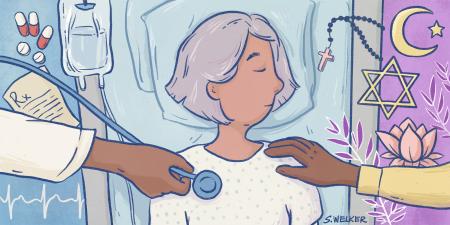Abstract
Spirituality is increasingly recognized as an essential element of patient care and health. It is often during illness that patients experience deep spiritual and existential suffering. With clinicians’ care and compassion, patients are able to find solace and healing through their spiritual beliefs and values. This article chronicles a history of spirituality and health education, including the development of consensus-based clinical guidelines and competencies in health professions education that have influenced the curricular development.
Need for Spirituality in Medicine
Spirituality is defined as a search for meaning, purpose, and transcendence and a connection to the significant or sacred.1,2 Illness, because it raises questions regarding meaning and value, can be described as a spiritual event. As Hebert et al. note, “To ignore the spiritual aspect of illness, then, is to ignore a significant dimension of the experience.”3 Yet medical training falls short of preparing physicians to help patients with the metaphysical needs of their illnesses.4 It is interesting that spirituality is not yet routinely addressed in clinical care, as most US adults believe in God or a universal spirit,5 patients can discover strength and solace in their spirituality, and data demonstrate the prevalence of spiritual distress.6 In this article, we chronicle the history of the field of spirituality and health, with its challenges, evolving definition, and integration into medical education.
Changing Roles of Spirituality in Medicine
Medicine, religion, and spirituality share a long history—as evidenced by the roles of healers such as priests and shamans. In the US, many hospitals were founded by religious organizations and espoused values of compassionate service. For centuries, medicine was a profession attending to both body and spirit, with patients often viewing physicians as “secular priests” who helped them grapple with the spiritual aspects of their illness.7As medical science emerged, contemporary physicians no longer saw it as their role to care for patients’ spirits. In 1910, the Flexner report sought to put medical education on a firm scientific footing by exposing its deficiencies.8 While the subsequent grounding of medical education in science resulted in tremendous advances in medicine, it also resulted in eliminating the humanistic and spiritual aspects of patient care. By the late twentieth century, there was a greater outcry from the public for more holistic and spiritual approaches to medical care.1
While more physicians are beginning to recognize that spirituality is a core patient need and has beneficial influences on health, some in the medical community think it “conflicts” with medical science.9 A major challenge in incorporating spirituality as a dimension of health stems from the difficulty in defining it. In attempting to define spirituality, one is discussing ways in which people view the purpose of their existence. Efforts have been made by consensus conferences on compassionate care to elucidate this concept.10 According to the 2013 International Consensus Conference on Improving the Spiritual Dimension of Whole Person Care, spirituality is defined as “A dynamic and intrinsic aspect of humanity through which persons seek ultimate meaning, purpose, and transcendence, and experience relationship to self, family, others, community, society, nature, and the significant or sacred. Spirituality is expressed through beliefs, values, traditions, and practices.”11 By this definition, spirituality is an inseparable aspect of humanity.
As we have entered an era in which patients suffer longer, traditional medicine’s goals of healing and relief from suffering become more pressing. As Egnew writes, “Suffering fills the chasm of meaninglessness that opens when the patient’s previously held meaning structures are destroyed.”4Saving and prolonging life incur a duty to “accompany patients on their illness journeys, to care for their souls as well as their bodies.”4 This duty aligns with the World Health Assembly’s palliative care guidelines, which states that all healthcare professionals have an ethical obligation to address all suffering of patients—psychosocial and spiritual.12
George Washington University’s Spirituality and Health Course
The senior author (CP) recognized the need for addressing spirituality as part of whole person care while a medical student at George Washington University. CP and colleagues at George Washington University started the first fully integrated elective course on spirituality and health in 1992 as a way to begin to broaden our understanding of patients from a holistic viewpoint, and in 1996 spirituality became integrated into the required GW School of Medicine curriculum. In collaboration with the Association of American Medical Colleges (AAMC), we held a consensus conference in 1999 to develop a definition of spirituality, learning objectives aimed at improving whole person care and facilitating professional growth (see table 1), and methods for developing courses on spirituality and health. This conference issued in a report published as part of the AAMC’s Medical School Objectives Project (MSOP).13 Subsequently, in 2001, the George Washington University started the first university-charted Institute for Spirituality and Health (GWish).14
| The ability to elicit a spiritual history |
| The ability to obtain a cultural history that elicits the patient’s cultural identity, experiences and explanations of illness, self-selected health practices, culturally relevant interpretations of social stress factors, and availability of culturally relevant support systems |
| An understanding that the spiritual dimension of people’s lives is an avenue for compassionate care giving |
| The ability to apply the understanding of a patient’s spirituality and cultural beliefs and behaviors to appropriate clinical contexts (e.g., in prevention, case formulation, treatment planning, challenging clinical situations) |
| Knowledge of research data on the impact of spirituality on health and on health care outcomes, and on the impact of patients’ cultural identity, beliefs, and practices on their health, access to and interactions with health care providers, and health outcomes |
| An understanding of, and respect for, the role of clergy and other spiritual leaders, and culturally-based healers and care providers, and how to communicate and/or collaborate with them on behalf of patients’ physical and/or spiritual needs |
| An understanding of their own spirituality and how it can be nurtured as part of their professional growth, promotion of their well-being, and the basis of their calling as a physician |
Reprinted with permission of the Association of American Medical Colleges.13
The Evolution and Growth of Spirituality in Medicine Courses
The content and the basis of spirituality in medical courses have changed from 1992 to the present. Initially, courses responded to patient need as demonstrated in surveys. For example, McCord et al. found that 83% of patients in a family practice setting “wanted physicians to ask about [their] spiritual beliefs in at least some circumstances.” Among those who wanted to discuss spirituality, 87% indicated “the most important reason for discussion was desire for physician-patient understanding.”15
As research demonstrated the relevance of spiritual and existential distress and guidelines for physicians attending to all aspects of patient suffering were developed, courses began to emphasize the clinical aspect of spirituality.10,16,17 These courses, which became widespread, now teach patient need for spirituality, diagnosis of spiritual and existential distress, and development of spiritual treatment plans. More recently, courses began to integrate the spirituality of the clinician as a way to help students identify with their role as healers.18 These courses also started integrating spirituality as a part of student wellness,19 particularly in response to the growing crisis of physician burnout, depression, and suicide.20
From 1996 to 2008, the senior author (CP) and GWish led a medical school and residency Spirituality and Health Curricular Awards program, which contributed to the increase in the number of US medical schools incorporating spirituality in their curriculum from 13% in 1994 to 90% by 2014 and to spirituality curricular integration in psychiatry and family medicine residency programs.21-23 To date, a total of 49 medical schools have received John Templeton Foundation funding for curricular development in spirituality and health.24
Based on these courses, the National Initiative to Develop National Competencies in Spirituality for Medical Education (NIDCSME), convened by GWish in 2009 through a consensus process, established spirituality-related competency behaviors, teaching methods, and assessment strategies for medical schools.25 The framework used was based on the existing Accreditation Council for Graduate Medical Education (ACGME) competencies.26 The concepts of compassionate presence—a subset of compassionate care—and student wellness were determined to be essential to these courses. “Presence” refers to the contemplative aspect of our relationship with patients. While compassionate care can involve empathy, forming connections, helping patients with issues, and being respectful and caring, presence calls upon a unique set of skills in which the clinician moves to a more reflective and contemplative space with the patient.10,16,17 Accompaniment, discussed earlier, is the outgrowth of presence.
The NIDCSME recommendations led to the development of a national program in professional development called GWish-Templeton Reflection Rounds (G-TRR). G-TRR is a mentored small group program that “aims to integrate meaning, purpose and connectedness into the continuum of medical education” by nurturing physicians’ inner growth through an interdisciplinary reflection process.27 These features relate to spirituality, broadly defined as finding meaning and purpose and experiencing connectedness to the sacred. Of the 33 participating medical schools in the G-TRR, 11 reported teaching more than 60% of competency behaviors,25with the highest prevalence in the compassionate presence domain. However, there are also barriers to implementing these behaviors in practice. Physicians’ most commonly cited barriers to initiating a spiritual history have been lack of an adequate framework during the clinical interview and perception of inability to offer time for such conversations.28In many ways, a spiritual history may not seem relevant in a routine appointment, but offering the space through genuine care beyond a problem list may provide an opportunity to heal in the most surprising of moments.
Despite these initiatives, physicians and trainees struggle with integrating spirituality into care, particularly into care near the end of life. In 2004, the National Consensus Project (NCP) for Quality Palliative Care developed 8 required domains of care, including spiritual, religious, and existential issues.29 In this document, assessment of patient spirituality is required; however, there were no guidelines on how to assess patient spirituality or how to choose the clinical team member who should make the assessment. Thus, in 2009, Puchalski and Ferrell co-led another national consensus conference that emphasized interprofessional spiritual care (with clinicians functioning as generalist spiritual care professionals and trained chaplainsas the experts on the care team). The conference addressed regular assessment by all members of the health care team and integration of spiritual issues into the medical plan as a fundamental component of quality palliative care.17 The guidelines motivated by this conference recognized spirituality not only as essential to care of the suffering but also as a fundamental aspect of preventative health. Spiritually-centered compassionate care should be key to any health delivery system.10
Last, the first global spiritual care train-the-trainer program—the Interprofessional Spiritual Care Education Curriculum (ISPEC)—will be launched in July 2018, led by GWish and the City of Hope in partnership with the Fetzer Institute.30 This training program for teaching interprofessional spiritual care was developed by the senior author (CP), Betty Ferrell from the City of Hope, and colleagues. The program contains a level 1 online component and a more advanced level 2 leadership train-the-trainer component for clinician-chaplain pairs of leaders to use at their clinical settings.
Based on the above consensus conferences, 22 years of curriculum development in US medical schools, and the professional development program (G-TRR), the GWU components for a spirituality and health curriculum fulfill both clinical and professional development components (see table 2). The clinical component includes taking a spiritual history, identifying patient spiritual resources, diagnosing spiritual or existential distress, and integrating spirituality into the assessment and treatment plan of patients. These objectives are intended to provide all medical students with training in how to address the spiritual concerns of patients, especially those with chronic and serious illnesses. Essential to this component is recognizing how to refer to and work with trained spiritual care professionals such as chaplains. In G-TRR, students experience their own spirituality in the context of their professional development as healers, as they reflect on themes of accompaniment and presence.
|
Patient care |
| Spiritual history |
| Spiritual distress diagnosis and treatment |
| Biopsychosocial spiritual assessment and treatment plan |
| Compassionate presence to persons’ suffering |
|
Student/resident/clinician formation |
| Inner life focus |
| Meaning, purpose, call to serve |
| Authenticity |
| Compassionate presence—to self |
Reproduced from C. Puchalski.31
Conclusion
Medical educators are increasingly recognizing the need to bring the art of compassionate care back into the curriculum.32 We must move away from asking whether spirituality should play a role in health care to examining ways this dominant force already functions in health care today. Given that (1) spirituality is associated with reduced mortality and risk for certain diseases,33 (2) there is a growing number of patients with chronic conditions and suffering, and (3) physician burnout is increasing,20addressing spirituality is both relevant and timely. Requiring spirituality as an integral component of medical education would bring medicine closer to the World Health Organization’s longstanding definition of health as “a state of complete physical, mental, and social well-being and not merely the absence of disease or infirmity,”34 updated with spirituality in the World Health Assembly’s palliative care resolution in 2014.12 We cannot serve our patients well if we only focus on the physical aspects of their illness, and neither can we rely on others on the team to take care of the psychosocial and spiritual issues as ancillary luxuries. The core element of the healing relationship is our ability to adequately address all the concerns of our patients and their families—psychosocial, spiritual, existential, and physical—and to work in partnership with experts in each of these domains. Anything less than this is both inadequate and unethical in meeting our professional obligation to our patients and their families.
References
- Sajja A, Puchalski C. Healing in modern medicine. Ann Palliat Med. 2017;6(3):206-210.
-
Sulmasy DP. The Healer’s Calling: A Spirituality for Physicians and Other Health Care Professionals. New York, NY: Paulist Press; 1997.
- Hebert RS, Jeckes MW, Ford DE, O’Connor DR, Cooper LA. Patient perspective on spirituality and the patient-physician relationship. J Gen Intern Med. 2001;16(10):685-692.
- Egnew TR. Suffering, meaning, and healing: challenges of contemporary medicine. Ann Fam Med. 2009;7(2):170-175.
-
Newport F. Most Americans still believe in God. Gallup. June 29, 2016. http://news.gallup.com/poll/193271/americans-believe-god.aspx. Accessed February 27, 2018.
-
des Ordons AR, Sinuff T, Stelfox HT, Kondejewski J, Sinclair S. Spiritual distress within inpatient settings—a scoping review of patient and family experiences [published online ahead of print March 14, 2018]. J Pain Symptom Manage. doi:10.1016/j.jpainsymman.2018.03.009.
-
Robbins BD. The Medicalized Body and Anesthetic Culture: The Cadaver, the Memorial Body, and the Recovery of Lived Experience. New York, NY: Palgrave Macmillan; 2018.
-
Flexner A. Medical Education in the United States and Canada: A Report to the Carnegie Foundation for the Advancement of Teaching. New York, NY: Carnegie Foundation for the Advancement of Teaching; 1910. Bulletin 4.
- Liao L. Spiritual care in medicine. JAMA. 2017;318(24):2495-2496.
- Puchalski CM, Vitillo R, Hull SK, Reller N. Improving the spiritual dimension of whole person care: reaching national and international consensus. J Palliat Med. 2014;17(6):642-656.
-
International Consensus Conference on Improving the Spiritual Dimension of Whole Person Care. Quoted in: Puchalski CM, Vitillo R, Hull SK, Reller N. Improving the spiritual dimension of whole person care: reaching national and international consensus. J Palliat Med. 2014;17(6):642-656.
-
World Health Assembly. Strengthening of palliative care as a component of comprehensive care throughout the life course. http://apps.who.int/gb/ebwha/pdf_files/WHA67/A67_R19-en.pdf. Published May 24, 2014. Accessed May 17, 2018.
-
Association of American Medical Colleges. Report III of the Medical School Objectives Project. Contemporary issues in medicine: communication in medicine.
https://members.aamc.org/eweb/upload/Contemporary%20Issues
%20In%20Med%20Commun%20in%20Medicine%20Report%20III%20.pdf. Published October 1999. Accessed February 27, 2018. -
GW Institute for Spirituality and Health, George Washington School of Medicine and Health Sciences. About GWish. https://smhs.gwu.edu/gwish/. Accessed May 17, 2018.
- McCord G, Gilchrist V, Grossman S, et al. Discussing spirituality with patients: a rational and ethical approach. Ann Fam Med. 2004;2(4):356-361.
- Puchalski CM, Blatt B, Kogan M, Butler A. Spirituality and health: the development of a field. Acad Med. 2014;89(1):10-16.
- Puchalski C, Ferrell B, Virani R, et al. Improving the quality of spiritual care as a dimension of palliative care: the report of the Consensus Conference. J Palliat Med. 2009;12(10):885-904.
- Todres ID, Catlin EA, Thiel MM. The intensivist in a spiritual care training program adapted for clinicians. Crit Care Med. 2005;33(12):2733-2736.
- Mitchell CM, Epstein-Peterson ZD, Bandini J, et al. Developing a medical school curriculum for psychological, moral, and spiritual wellness: student and faculty perspectives. J Pain Symptom Manage. 2016;52(5):727-736.
- Kuhn CM, Flanagan EM. Self-care as a professional imperative: physician burnout, depression, and suicide. Can J Anaesth. 2017;64(2):158-168.
-
Blumberg A. The case for incorporating spiritual care in medicine. Huff Post. https://www.huffingtonpost.com/entry/spirituality-and-health-care_us_58055adae4b0b994d4c10f6f. Published December 8, 2016. Accessed May 30, 2018.
- Kozak L, Boynton L, Bentley J, Bezy E. Introducing spirituality, religion and culture criteria in the psychiatry residency programme. Med Humanit. 2010;36(1):48-51.
- King DE, Crisp J. Spirituality and health care education in family medicine residency programs. Fam Med. 2005;37(6):399-403.
-
GW Institute for Spirituality and Health, George Washington School of Medicine and Health Sciences. Award for curriculum development in medical schools. https://smhs.gwu.edu/gwish/education/awards/medical-schools. Accessed May 17, 2018.
-
Balboni M, Peteet J. Spirituality and Religion within the Culture of Medicine: From Evidence to Practice. New York, NY: Oxford University Press; 2017.
-
Accreditation Council for Graduate Medical Education. Program director guide to the common program requirements. http://uthscsa.edu/gme/documents/ACGME%20CompleteGuide_v2.pdf. Updated July 2011. Accessed February 27, 2018.
-
GW Institute for Spirituality and Health, George Washington School of Medicine and Health Sciences. GWish Templeton Reflection Rounds Facilitator Training Program. https://smhs.gwu.edu/gwish/events/gwish-templeton-reflections-rounds-facilitator-training-program. Accessed May 17, 2018.
- Balboni TA, Paulk ME, Balboni MJ, et al. Provision of spiritual care to patients with advanced cancer: associations with medical care and quality of life near death. J Clin Oncol. 2010;28(3):445-452.
-
American Academy of Hospice and Palliative Medicine; Center to Advance Palliative Care; Hospice and Palliative Nurses Association; Last Acts Partnership; National Hospice and Palliative Care Organization. National Consensus Project for Quality Palliative Care: clinical practice guidelines for quality palliative care, executive summary. J Palliat Med. 2004;7(5):611-627.
-
GW Institute for Spirituality and Health, George Washington School of Medicine and Health Sciences. Interprofessional spiritual care education curriculum (ISPEC). https://smhs.gwu.edu/gwish/interprofessional-spiritual-care-education-curriculum-ispec. Accessed May 17, 2018.
-
Puchalski C. Integrating spiritual care into palliative care: a whole person approach. Pontifical Academy for Life. http://www.academyforlife.va/content/dam/pav/documents/170904
%20PALLIFE%20talk.pdf. Published August 24, 2017. Accessed May 17, 2018. - Puchalski CM, Larson DB. Developing curricula in spirituality and medicine. Acad Med. 1998;73(9):970-974.
- Masters KS, Hooker SA. Religiousness/spirituality, cardiovascular disease, and cancer: cultural integration for health research and intervention. J Consult Clin Psychol. 2013;81(2):206-216.
-
World Health Organization. Constitution of WHO: principles. http://www.who.int/about/mission/en/. Accessed Jan 17, 2017.



